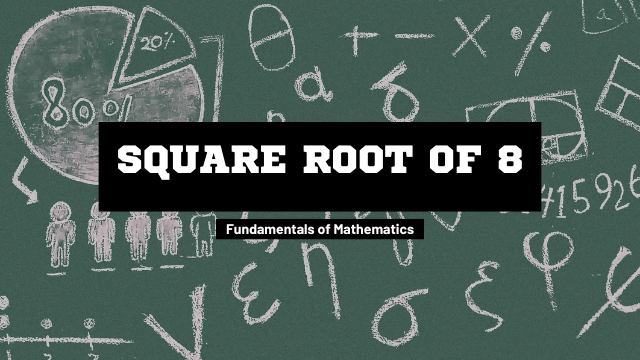Diving Deep into the Square Root of 8: A Mathematical Exploration

Diving Deep into the Square Root of 8: A Mathematical Exploration
Introduction:
Mathematics is a vast universe, teeming with numbers, symbols, and operations that interweave to form the fabric of our understanding of the quantitative world. One such intriguing number, lying between the perfect squares of 4 and 9, is 8. At first glance, 8 might appear to be a straightforward, even number, but when we examine its square root, we delve into a world filled with irrationality, history, and geometric wonder. In this exploration, we will dive deep into the square root of 8, unearthing its value, its properties, and its significance in the realm of mathematics.
Also Read:- Square Root 1 to 20- Definition, Properties, Examples
Explanation:
The square root of a number is defined as a value that, when multiplied by itself, gives the original number. For instance, the square root of 9 is 3 because 3×3=9. But what happens when a number isn’t a perfect square? This is where the square root of 8 becomes a subject of intrigue.
To understand 8, we first simplify it:
8=4×2
Using properties of radicals, we can express this as:
8=4×2=22
Here, 22 is an irrational number, meaning it cannot be expressed as a precise fraction, and its decimal representation goes on indefinitely without repeating. Approximately, 8 is equal to 2.828.
But the square root of 8 is not just about its value. Its existence and properties have implications in various areas of mathematics:
- Geometry: In the Pythagorean theorem, if you have a right triangle with one side of length 2 and a hypotenuse of length 22, the other side will also have a length of 2. This forms a 45-45-90 right triangle, a special triangle where the two legs are congruent.
- Algebra: Rationalizing the denominator often involves numbers like 8. For instance, if you’re working with the fraction 18, rationalizing would involve multiplying the numerator and denominator by 2, resulting in 24.
- History: The ancient Greeks discovered that numbers like 8 were irrational, leading to significant philosophical debates and further mathematical inquiries.
In conclusion, the square root of 8, while seemingly simple, opens the door to a world of mathematical concepts, from the properties of radicals to geometric principles. It exemplifies the beauty of numbers and their intertwined relationships, reminding us that even the most basic mathematical inquiries can lead to profound discoveries.









